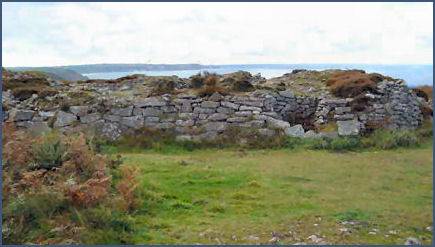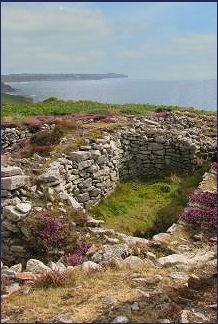Ballowall Barrow
OS Grid ref:- SW355313
 Situated in a spectacular cliff-edge position, overlooking the rugged granite cliffs to the south of Cape Cornwall, Ballowall Barrow, otherwise known as Carn Glaze lies on Ballowall Common, around a mile from the town of St. Just-in-Penwith. Ballowall Barrow is located within a landscape rich in prehistoric monuments, settlements and field systems.
Situated in a spectacular cliff-edge position, overlooking the rugged granite cliffs to the south of Cape Cornwall, Ballowall Barrow, otherwise known as Carn Glaze lies on Ballowall Common, around a mile from the town of St. Just-in-Penwith. Ballowall Barrow is located within a landscape rich in prehistoric monuments, settlements and field systems.
The large and complex barrow, which is also known as Carn Gluze Barrow, measures 72 feet (22 metres) in diameter. It is a complex of barrows and cists from different periods, spanning the Neolithic and Bronze Ages (3500-2500BC), and the only one of its kind in Cornwall. Remaining hidden under rubble from nearby mining activity for centuries significantly contributed to its preservation
 The elaborate and unusual monument consists of a round chambered cairn or entrance grave located in a panoramic position on the edge of the Atlantic coast, with superb views from Cape Cornwall to Sennen, in clear weather, the Scilly Isles may be sighted from the cairn. The barrow entrance faces southwest towards the setting sun.
The elaborate and unusual monument consists of a round chambered cairn or entrance grave located in a panoramic position on the edge of the Atlantic coast, with superb views from Cape Cornwall to Sennen, in clear weather, the Scilly Isles may be sighted from the cairn. The barrow entrance faces southwest towards the setting sun.
Ballowall Barrow was excavated in 1874 by the antiquarian William Copeland Borlase when it was discovered under mining debris, In the centre of the barrow was a mound surrounded by two concentric drystone walls. Contained within it were five small stone-lined chambers, known as cists burnt human bones and fragments of pottery, dating from the Bronze Age and a Roman coin were discovered.
The site we see today is a mix of the original and reconstructions carried out by Borlase. After the excavation, he built stone walls to display important features of the barrow, creating a circular passage between the central mound and apron. This radically altered the appearance of the site.
The site is in the guardianship of English Heritage, and is managed by the National Trust.
Directions
Leave St. Just by the Cape Cornwall road Turn left after the houses on the left and continue along the road to Carn Gloose.